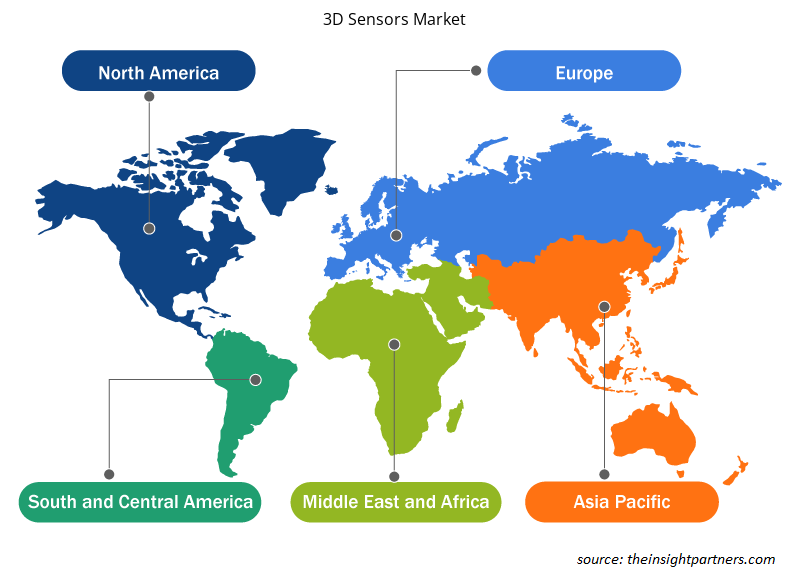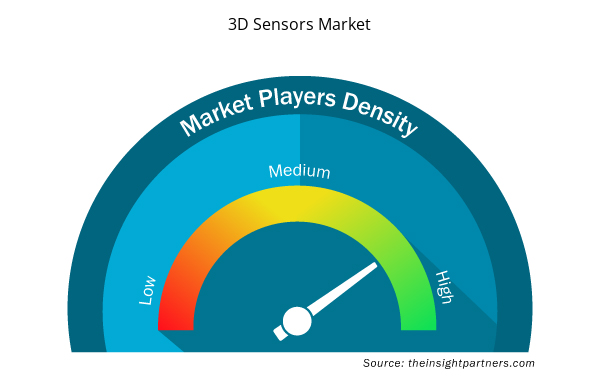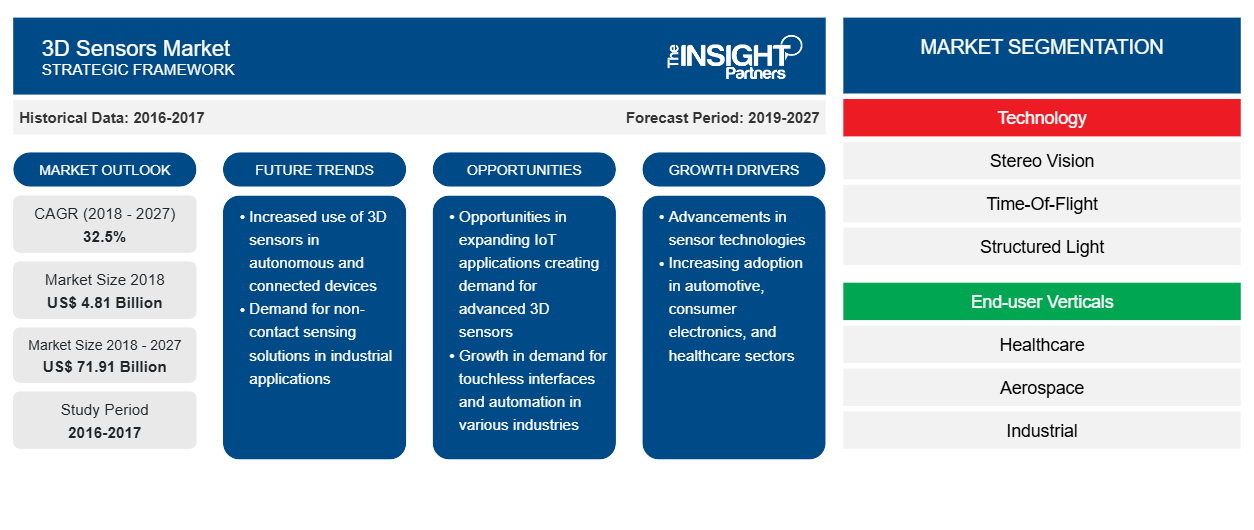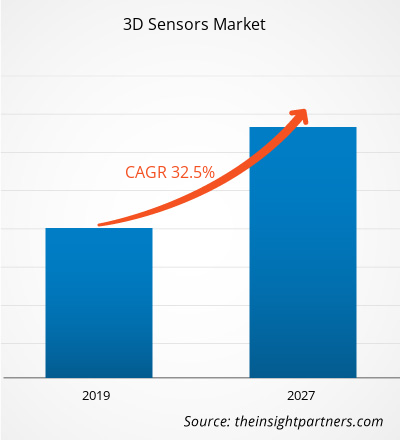[تقرير بحثي] بلغت قيمة سوق أجهزة الاستشعار ثلاثية الأبعاد 4,805.7 مليون دولار أمريكي في عام 2018 ومن المتوقع أن تصل إلى 71,914.2 مليون دولار أمريكي بحلول عام 2027؛ ومن المتوقع أن ينمو بمعدل نمو سنوي مركب قدره 32.5٪ خلال الفترة 2019-2027.
تستخدم أجهزة الاستشعار ثلاثية الأبعاد أجهزة استشعار ذات نطاق نشط توفر صورًا عميقة بمعدلات إطارات عالية. تم تجهيز هذه الكاميرات بمصدر ضوء الأشعة تحت الحمراء الذي ينير المجال، ومستشعر CMOS/CCD الذي يلتقط ضوء الأشعة تحت الحمراء المنعكس. يعتمد قياس العمق على مبدأ ToF؛ وبالتالي، فإن العمق يتناسب مع الوقت الذي تقضيه إشارة الأشعة تحت الحمراء للوصول إلى الكائن أو مجال المراقبة والعودة. تنتج قياسات العمق التي تم الحصول عليها لكل بكسل من المستشعر معًا صورة عمق. يعد الاستحواذ السريع على صور العمق مفيدًا للغاية في مجموعة واسعة من المجالات الرأسية للمستخدم النهائي، مثل الروبوتات، والتفاعل بين الإنسان والآلة، ونمذجة المشهد. لسوء الحظ، فإن العديد من كاميرات ToF المتاحة حاليًا ذات دقة منخفضة وتتأثر بأخطاء قياس مختلفة، بما في ذلك الضوضاء التي تسببها أجهزة الاستشعار، وخطأ الاهتزاز المنهجي بسبب صعوبة توليد إشارات جيبية، وإزاحات العمق غير الخطية التي تعتمد على الانعكاس ووقت التكامل، والبكسلات الطائرة الناتجة عن تراكب الإشارات عند عدم تجانس العمق (الحواف). ونتيجة لذلك، توفر أجهزة استشعار ToF قياسات عمق دقيقة ومحددة. تركز أنظمة الاستشعار متعددة ToF المتاحة حاليًا على الجمع بين صور العمق لبناء عمليات إعادة بناء ثلاثية الأبعاد من خلال الاعتماد على شبكات احتمالية الإشغال أو تسجيل السحب النقطية الناتجة عن وجهات نظر مختلفة، وما إلى ذلك.
تُستخدم تقنيات ToF منذ أكثر من عقد من الزمان لأغراض تحديد المدى. السونار والرادار هما التقنيتان اللتان تستغلان إشارات الصوت والراديو لمبادئ ToF، وخاصة في المجالات الرأسية للمستخدم النهائي في مجال الفضاء والطيران. وفي الآونة الأخيرة، مع تحسن الأجهزة الإلكترونية ونضجها، أصبح من الممكن استخدام إشارات الضوء لأنظمة ToF. وهناك العديد من المجالات الرأسية للمستخدم النهائي التي تستخدم مثل هذا النظام، وخاصة في المجالات الصناعية والاستهلاكية. وبشكل عام، هناك تقنيتان لقياس المسافة باستخدام أجهزة استشعار ToF الحديثة: التعديل النبضي أو التعديل الموجي المستمر (CW). وتستخدم أنظمة ToF المتقدمة تقنيات متعددة الترددات، تجمع بين المزيد من ترددات التعديل.
قم بتخصيص هذا التقرير ليناسب متطلباتك
ستحصل على تخصيص لأي تقرير - مجانًا - بما في ذلك أجزاء من هذا التقرير، أو تحليل على مستوى الدولة، وحزمة بيانات Excel، بالإضافة إلى الاستفادة من العروض والخصومات الرائعة للشركات الناشئة والجامعات
- احصل على أهم اتجاهات السوق الرئيسية لهذا التقرير.ستتضمن هذه العينة المجانية تحليلاً للبيانات، بدءًا من اتجاهات السوق وحتى التقديرات والتوقعات.
رؤى إقليمية حول سوق أجهزة الاستشعار ثلاثية الأبعاد
لقد قام المحللون في Insight Partners بشرح الاتجاهات والعوامل الإقليمية المؤثرة على سوق أجهزة الاستشعار ثلاثية الأبعاد طوال فترة التوقعات بشكل شامل. يناقش هذا القسم أيضًا قطاعات سوق أجهزة الاستشعار ثلاثية الأبعاد والجغرافيا في جميع أنحاء أمريكا الشمالية وأوروبا ومنطقة آسيا والمحيط الهادئ والشرق الأوسط وأفريقيا وأمريكا الجنوبية والوسطى.

- احصل على البيانات الإقليمية المحددة لسوق أجهزة الاستشعار ثلاثية الأبعاد
نطاق تقرير سوق أجهزة الاستشعار ثلاثية الأبعاد
| سمة التقرير | تفاصيل |
|---|---|
| حجم السوق في عام 2018 | 4.81 مليار دولار أمريكي |
| حجم السوق بحلول عام 2027 | 71.91 مليار دولار أمريكي |
| معدل النمو السنوي المركب العالمي (2018 - 2027) | 32.5% |
| البيانات التاريخية | 2016-2017 |
| فترة التنبؤ | 2019-2027 |
| القطاعات المغطاة | حسب التكنولوجيا
|
| المناطق والدول المغطاة | أمريكا الشمالية
|
| قادة السوق وملفات تعريف الشركات الرئيسية |
|
كثافة اللاعبين في سوق أجهزة الاستشعار ثلاثية الأبعاد: فهم تأثيرها على ديناميكيات الأعمال
يشهد سوق أجهزة الاستشعار ثلاثية الأبعاد نموًا سريعًا، مدفوعًا بالطلب المتزايد من المستخدم النهائي بسبب عوامل مثل تفضيلات المستهلك المتطورة والتقدم التكنولوجي والوعي المتزايد بفوائد المنتج. ومع ارتفاع الطلب، تعمل الشركات على توسيع عروضها والابتكار لتلبية احتياجات المستهلكين والاستفادة من الاتجاهات الناشئة، مما يؤدي إلى زيادة نمو السوق.
تشير كثافة اللاعبين في السوق إلى توزيع الشركات أو المؤسسات العاملة في سوق أو صناعة معينة. وهي تشير إلى عدد المنافسين (اللاعبين في السوق) الموجودين في مساحة سوق معينة نسبة إلى حجمها أو قيمتها السوقية الإجمالية.
الشركات الرئيسية العاملة في سوق أجهزة الاستشعار ثلاثية الأبعاد هي:
- شركة ايه ام اس ايه جي
- شركة إنفينيون للتكنولوجيا
- شركة اي اف ام الكترونيك المحدودة
- ميليكسيس
- شركة سوني
إخلاء المسؤولية : الشركات المذكورة أعلاه ليست مرتبة بأي ترتيب معين.

- احصل على نظرة عامة على أهم اللاعبين الرئيسيين في سوق أجهزة الاستشعار ثلاثية الأبعاد
تم تقسيم سوق أجهزة الاستشعار ثلاثية الأبعاد العالمية على النحو التالي:
السوق العالمية لأجهزة الاستشعار ثلاثية الأبعاد – حسب التكنولوجيا
- رؤية ستيريو
- زمن الرحلة
- الضوء المنظم
السوق العالمية لأجهزة الاستشعار ثلاثية الأبعاد – حسب فئات المستخدم النهائي
- الرعاية الصحية
- الفضاء الجوي
- صناعي
- السيارات
- الالكترونيات الاستهلاكية
- آحرون
السوق العالمية لأجهزة الاستشعار ثلاثية الأبعاد – حسب المنطقة الجغرافية
أمريكا الشمالية
- نحن
- كندا
- المكسيك
أوروبا
- ألمانيا
- فرنسا
- إيطاليا
- المملكة المتحدة
- روسيا
- بقية أوروبا
آسيا والمحيط الهادئ (APAC)
- الصين
- أستراليا
- الهند
- اليابان
- كوريا الجنوبية
- بقية آسيا والمحيط الهادئ
الشرق الأوسط وأفريقيا
- المملكة العربية السعودية
- جنوب أفريقيا
- الامارات العربية المتحدة
- بقية الشرق الأوسط وأفريقيا
أمريكا الجنوبية
- الأرجنتين
- البرازيل
- بقية أمريكا الجنوبية
نبذة عن الشركة
- شركة ايه ام اس ايه جي
- شركة إنفينيون للتكنولوجيا
- شركة اي اف ام الكترونيك المحدودة
- ميليكسيس
- شركة سوني
- شركة إس تي ميكروإلكترونيكس إن في
- شركة باسلر
- شركة كوجنكس
- شركة أومني فيجن للتكنولوجيا
- شركة إل إم آي للتكنولوجيا
- التحليل التاريخي (سنتان)، السنة الأساسية، التوقعات (7 سنوات) مع معدل النمو السنوي المركب
- تحليل PEST و SWOT
- حجم السوق والقيمة / الحجم - عالميًا وإقليميًا وقطريًا
- الصناعة والمنافسة
- مجموعة بيانات Excel


- Molecular Diagnostics Market
- Precast Concrete Market
- Non-Emergency Medical Transportation Market
- Visualization and 3D Rendering Software Market
- Military Rubber Tracks Market
- Genetic Testing Services Market
- Railway Braking System Market
- Adaptive Traffic Control System Market
- Sleep Apnea Diagnostics Market
- Print Management Software Market

Report Coverage
Revenue forecast, Company Analysis, Industry landscape, Growth factors, and Trends

Segment Covered
This text is related
to segments covered.

Regional Scope
North America, Europe, Asia Pacific, Middle East & Africa, South & Central America

Country Scope
This text is related
to country scope.
الأسئلة الشائعة
Growing demand for the 3D sensor is a major breakthrough in technology. It is a deep sensing technology that enhances the capacity of a camera to recognize faces and objects. Major companies are using this technology for the development of face recognition in mobile phones and also to accelerate the development and commercialization of high resolution, low power active 3D depth-sensing camera system.
The Asia Pacific region led the 3D sensor market with a market share of 48.3%in 2018. The continuous economic growth in developed and developing countries like India and China, coupled with the presence of huge disposable incomes with individuals in countries like Japan and Australia, has facilitated the rapid growth of the automotive industry in this region. The Asia Pacific is one of the world’s rapidly growing consumer electronic with China accounting for maximum 3D sensor device production. The rapid growth in industrialization and urbanization in the economy is positively impacting the growth of the 3D sensor market in the APAC region. Moreover, the market for the 3D sensor is expected to rise with the growth of end-user verticals industries.
The leading type of 3D sensor is the Time-of-Flight (ToF) that has noted to account a CAGR of 41.9%. ToF is regarded as the sensor that has materialized as a promising three-dimensional (3D) sensing technology that can be manufactured economically in a compact size. In ToF, an infrared strobe emits a bright, short pulse, and a custom detector with a very fast shutter speed measures the time that the light travels before hitting an object. However, current state-of-the-art ToF sensors suffer from low spatial resolution due to physical limitations in the fabrication process
The List of Companies
- AMS AG
- Infineon Technologies AG
- ifm electronic gmbh
- Melexis
- Sony Corporation
- STMicroelectronics N.V.
- Basler AG
- Cognex Corporation
- OmniVision Technologies, Inc.
- LMI Technologies Inc
The Insight Partners performs research in 4 major stages: Data Collection & Secondary Research, Primary Research, Data Analysis and Data Triangulation & Final Review.
- Data Collection and Secondary Research:
As a market research and consulting firm operating from a decade, we have published and advised several client across the globe. First step for any study will start with an assessment of currently available data and insights from existing reports. Further, historical and current market information is collected from Investor Presentations, Annual Reports, SEC Filings, etc., and other information related to company’s performance and market positioning are gathered from Paid Databases (Factiva, Hoovers, and Reuters) and various other publications available in public domain.
Several associations trade associates, technical forums, institutes, societies and organization are accessed to gain technical as well as market related insights through their publications such as research papers, blogs and press releases related to the studies are referred to get cues about the market. Further, white papers, journals, magazines, and other news articles published in last 3 years are scrutinized and analyzed to understand the current market trends.
- Primary Research:
The primarily interview analysis comprise of data obtained from industry participants interview and answers to survey questions gathered by in-house primary team.
For primary research, interviews are conducted with industry experts/CEOs/Marketing Managers/VPs/Subject Matter Experts from both demand and supply side to get a 360-degree view of the market. The primary team conducts several interviews based on the complexity of the markets to understand the various market trends and dynamics which makes research more credible and precise.
A typical research interview fulfils the following functions:
- Provides first-hand information on the market size, market trends, growth trends, competitive landscape, and outlook
- Validates and strengthens in-house secondary research findings
- Develops the analysis team’s expertise and market understanding
Primary research involves email interactions and telephone interviews for each market, category, segment, and sub-segment across geographies. The participants who typically take part in such a process include, but are not limited to:
- Industry participants: VPs, business development managers, market intelligence managers and national sales managers
- Outside experts: Valuation experts, research analysts and key opinion leaders specializing in the electronics and semiconductor industry.
Below is the breakup of our primary respondents by company, designation, and region:

Once we receive the confirmation from primary research sources or primary respondents, we finalize the base year market estimation and forecast the data as per the macroeconomic and microeconomic factors assessed during data collection.
- Data Analysis:
Once data is validated through both secondary as well as primary respondents, we finalize the market estimations by hypothesis formulation and factor analysis at regional and country level.
- Macro-Economic Factor Analysis:
We analyse macroeconomic indicators such the gross domestic product (GDP), increase in the demand for goods and services across industries, technological advancement, regional economic growth, governmental policies, the influence of COVID-19, PEST analysis, and other aspects. This analysis aids in setting benchmarks for various nations/regions and approximating market splits. Additionally, the general trend of the aforementioned components aid in determining the market's development possibilities.
- Country Level Data:
Various factors that are especially aligned to the country are taken into account to determine the market size for a certain area and country, including the presence of vendors, such as headquarters and offices, the country's GDP, demand patterns, and industry growth. To comprehend the market dynamics for the nation, a number of growth variables, inhibitors, application areas, and current market trends are researched. The aforementioned elements aid in determining the country's overall market's growth potential.
- Company Profile:
The “Table of Contents” is formulated by listing and analyzing more than 25 - 30 companies operating in the market ecosystem across geographies. However, we profile only 10 companies as a standard practice in our syndicate reports. These 10 companies comprise leading, emerging, and regional players. Nonetheless, our analysis is not restricted to the 10 listed companies, we also analyze other companies present in the market to develop a holistic view and understand the prevailing trends. The “Company Profiles” section in the report covers key facts, business description, products & services, financial information, SWOT analysis, and key developments. The financial information presented is extracted from the annual reports and official documents of the publicly listed companies. Upon collecting the information for the sections of respective companies, we verify them via various primary sources and then compile the data in respective company profiles. The company level information helps us in deriving the base number as well as in forecasting the market size.
- Developing Base Number:
Aggregation of sales statistics (2020-2022) and macro-economic factor, and other secondary and primary research insights are utilized to arrive at base number and related market shares for 2022. The data gaps are identified in this step and relevant market data is analyzed, collected from paid primary interviews or databases. On finalizing the base year market size, forecasts are developed on the basis of macro-economic, industry and market growth factors and company level analysis.
- Data Triangulation and Final Review:
The market findings and base year market size calculations are validated from supply as well as demand side. Demand side validations are based on macro-economic factor analysis and benchmarks for respective regions and countries. In case of supply side validations, revenues of major companies are estimated (in case not available) based on industry benchmark, approximate number of employees, product portfolio, and primary interviews revenues are gathered. Further revenue from target product/service segment is assessed to avoid overshooting of market statistics. In case of heavy deviations between supply and demand side values, all thes steps are repeated to achieve synchronization.
We follow an iterative model, wherein we share our research findings with Subject Matter Experts (SME’s) and Key Opinion Leaders (KOLs) until consensus view of the market is not formulated – this model negates any drastic deviation in the opinions of experts. Only validated and universally acceptable research findings are quoted in our reports.
We have important check points that we use to validate our research findings – which we call – data triangulation, where we validate the information, we generate from secondary sources with primary interviews and then we re-validate with our internal data bases and Subject matter experts. This comprehensive model enables us to deliver high quality, reliable data in shortest possible time.


 احصل على عينة مجانية لهذا التقرير
احصل على عينة مجانية لهذا التقرير